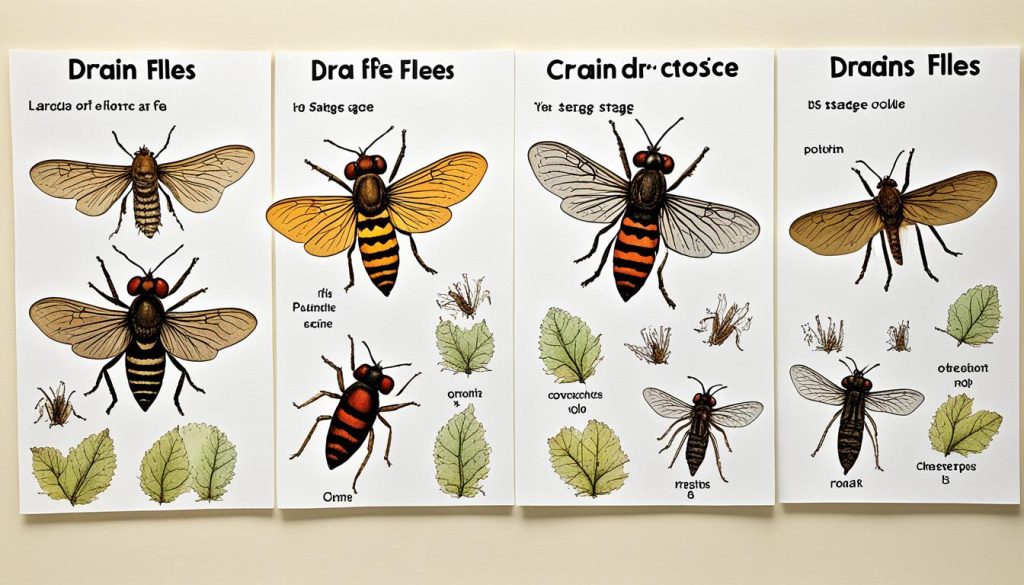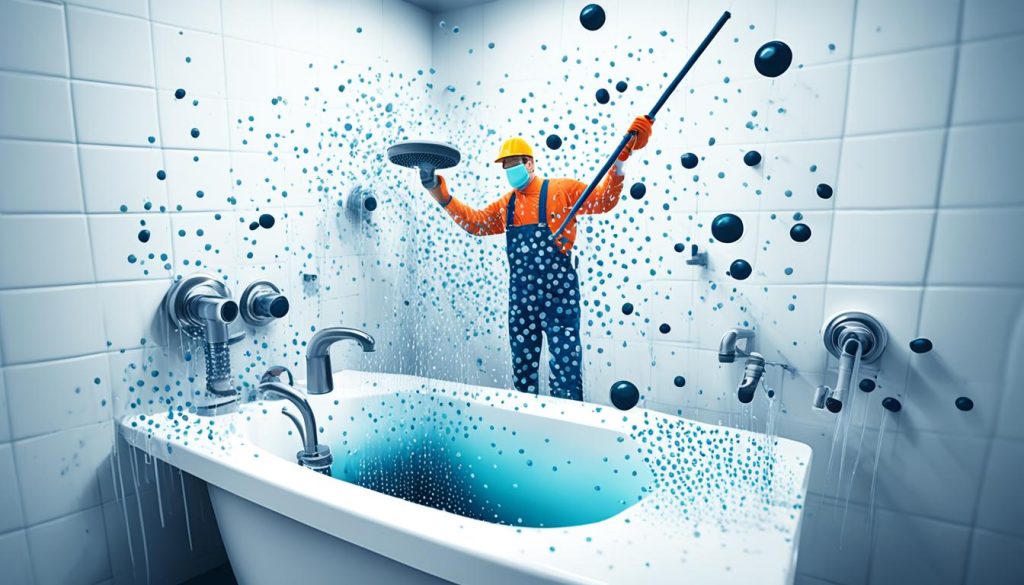Drain Flies Uncovered: What Do They Look Like?
Did you know that drain flies, also known as sewer flies or sink flies, are small insects that measure only about an eighth of an inch in length? Despite their tiny size, these pests can cause significant nuisance and frustration when they infest our homes. Understanding what drain flies look like and how to identify them is essential in effectively dealing with these pesky intruders.
Key Takeaways:
- Drain flies are small insects that measure about an eighth of an inch in length.
- They are commonly found near drains, sewers, septic tanks, and sewage-contaminated soil.
- Drain flies have a black or brown color and a unique vein pattern in their wings.
- Their slim body differentiates them from fruit flies, which have spread-out wings.
- Regular cleaning of drains and preventing stagnant water can help prevent drain fly infestations.
Identifying Drain Flies
When it comes to identifying drain flies, there are a few key features that can help you distinguish them from other small insects. Drain flies are about an eighth of an inch long and typically have a black or brown color. This can often cause them to be mistaken for fruit flies or gnats.
One of the distinguishing characteristics of drain flies is their unique vein pattern in their wings. These wings are covered in tiny hairs, giving them a distinct appearance. When crushed, drain flies leave behind a powdery smudge, which can further help in their identification.
Unlike fruit flies, drain flies have a sleek body rather than spread-out wings. This physical difference sets them apart and aids in their recognition. If you spot small flies near drains, sewers, septic tanks, or sewage-contaminated soil, there’s a good chance they are drain flies.
Drain flies are commonly found in bathroom and kitchen areas, specifically around sinks and shower drains. Understanding their appearance and typical habitats can be instrumental in implementing appropriate control measures.
Recognizing and properly identifying drain flies is the first step in dealing with potential infestations and taking necessary measures to eliminate them from your living spaces.
The Life Cycle of Drain Flies
Understanding the life cycle of drain flies is essential for effective control and elimination of these pests. Drain flies, also known as sewer flies, filter flies, moth flies, or sink flies, have a life cycle that lasts 1-3 weeks. Let’s take a closer look at each stage of their development.
Eggs:
Female drain flies lay brown or cream-colored eggs in environments with organic matter, such as drains or garbage disposal areas. These eggs are typically small and difficult to spot without magnification. They usually hatch within 2 days, giving rise to drain fly larvae.
Larvae:
Drain fly larvae, also known as maggots, are about one-quarter of an inch long. They have skinny bodies with no legs and are commonly found in the larval stage feeding on drain sludge. This organic matter provides the necessary nutrients for their growth and development. The larval stage typically lasts approximately nine to 15 days.
Pupae:
After the larval stage, drain fly larvae pupate. Pupae are the transitional phase between larvae and adult drain flies. During this stage, they undergo metamorphosis. The pupal stage can last for several days as the drain fly transforms inside a cocoon-like structure.
Adults:
Once the transformation is complete, adult drain flies emerge from the pupal stage. They are now fully developed and capable of flight. Adult drain flies have wings and are the reproductive stage of their life cycle. They can mate and lay eggs, starting the cycle anew.
Below is a summary of the drain fly life cycle:
| Stage | Duration | Description |
|---|---|---|
| Eggs | 2 days | Brown or cream-colored eggs laid by female drain flies |
| Larvae | 9-15 days | Skinny, legless drain fly larvae feeding on drain sludge |
| Pupae | Several days | Pupal stage where drain flies undergo metamorphosis |
| Adults | Continual | Fully developed drain flies capable of flight, reproduction, and egg laying |
Understanding the life cycle of drain flies helps in implementing targeted control measures and effectively preventing their infestation. By disrupting their life cycle through proper cleaning and maintenance of drains, you can significantly reduce the presence of drain flies in your home.
Where Do Drain Flies Come From?
Drain flies, also known as sewer flies, filter flies, moth flies, or sink flies, have specific habitats and breeding grounds. Understanding these locations can help in preventing and controlling drain fly infestations.
Drain flies primarily live in drains, sewers, septic tanks, and sewage-contaminated soil. These areas provide them with a constant source of moisture and organic matter, which they need for sustenance. However, drain flies can also be found in other places that meet their requirements.
In indoor environments, drain flies commonly inhabit sinks, bathtubs, shower drains, and lesser-used toilets. They may also be present in refrigerator drain pans and loose ceramic tiles where water can collect. These areas often have a buildup of organic debris and moisture, creating a suitable breeding ground for drain flies.
Common Indoor Habitat and Breeding Grounds for Drain Flies:
- Sinks
- Bathtubs
- Shower drains
- Lesser-used toilets
- Refrigerator drain pans
- Loose ceramic tiles with water collection
It is important to note that drain flies can also be found in outdoor areas. Faulty septic lines, air conditioner drains, areas where rainwater collects, and places with algae or mold growth can attract drain flies. These areas provide the necessary conditions, such as stagnant water and decomposed organic matter, for drain flies to thrive.
Common Outdoor Habitat and Breeding Grounds for Drain Flies:
- Faulty septic lines
- Air conditioner drains
- Areas where rainwater collects
- Places with algae or mold growth
By being aware of the typical habitats and breeding grounds of drain flies, you can take proactive measures to prevent infestations. Regular cleaning of drains, eliminating stagnant water, and addressing any moisture issues can help create an inhospitable environment for drain flies.
Preventing Drain Flies
To prevent drain flies and keep your drains clean, it is important to establish regular drain maintenance and cleaning practices. By eliminating stagnant water and taking proactive measures, you can create an environment that is unsuitable for drain fly infestations.
Regular Drain Cleaning
Regular cleaning of your drains is essential to prevent the buildup of sludge and organic matter that drain flies feed on. Use simple household ingredients like dish soap, vinegar, or hot water to cleanse your drains and remove any potential food sources for drain flies.
Preventing Stagnant Water
Stagnant water provides an ideal breeding ground for drain flies. To prevent stagnation, make it a habit to run water down your drains for about a minute once a week. This will help to flush out any stagnant water and ensure that your drains are flowing freely.
Effective Drain Maintenance
Proper drain maintenance involves keeping your drains clean and free from debris. In addition to regular cleaning, consider using a mixture of salt, baking soda, and white vinegar to clear your drains and deter drain flies. This combination can help to break down organic matter and keep your drains clear.
By implementing these preventative measures and maintaining a clean and clear drain system, you can significantly reduce the risk of drain fly infestations in your home.
| Preventive Measures | Benefits |
|---|---|
| Regular drain cleaning | – Removes sludge and organic matter – Discourages drain fly larvae development |
| Eliminating stagnant water | – Prevents drain fly breeding – Keeps drains flowing freely |
| Effective drain maintenance | – Removes debris and potential food sources – Discourages drain fly infestations |
Getting Rid of Drain Flies
When it comes to getting rid of drain flies, there are several approaches you can take. While DIY methods can be effective to some extent, it is advisable to seek professional pest control services for comprehensive drain fly removal.
If you prefer taking matters into your own hands, you can try using traps or boiling water. Traps can be easily made by placing cups or jars coated with petroleum jelly or vegetable oil over drain openings. These traps help catch drain flies and reduce their population.
Another DIY method involves pouring boiling water down drains to kill adult drain flies. However, it’s important to note that this method may not address the root cause of the infestation.
For a more effective and long-lasting solution, professional pest control companies are the best option. These experts have the knowledge, experience, and resources to identify the breeding sources of drain flies and provide targeted treatments to eliminate the infestations.
By opting for professional pest control, you can ensure the safety and effectiveness of the removal process. Additionally, these services can help prevent future drain fly infestations, giving you peace of mind.
Summary and Conclusion
Drain flies, also known as sewer flies, filter flies, moth flies, or sink flies, are small insects that can be a nuisance when present in large numbers. These black or brown flies, measuring about an eighth of an inch in length, are commonly found near drains, sewers, septic tanks, and sewage-contaminated soil. One distinguishing characteristic is the unique vein pattern in their wings. Drain flies feed on organic matter, and their presence can indicate a buildup of sludge in drains.
To effectively deal with drain fly infestations, it is important to understand their life cycle and habits. Drain flies have a life cycle of 1-3 weeks, with eggs that hatch in 2 days and larvae that feed on drain sludge. Regular drain cleaning is essential to prevent drain fly populations from multiplying. Eliminating stagnant water and moisture sources is also crucial, as drain flies are attracted to such environments.
In cases of severe infestations, it is recommended to seek professional pest control services. Pest control experts have the knowledge and resources to identify breeding sources and provide targeted treatments for eliminating drain flies. Their expertise ensures the safety and effectiveness of the removal process, as well as the prevention of future infestations.
In conclusion, understanding the characteristics, habits, and preventive measures related to drain flies can help in identifying and controlling these pesky insects. Regular drain maintenance, proper sanitation practices, and professional pest control services are key steps in eliminating drain flies from your home and preventing their recurrence.
- Investing Wisely: How Windows & Doors in Boost Property Value and Financial Health - April 24, 2025
- The Financial Impact of Personal Injuries: Why Legal Help Matters for Business Owners - April 16, 2025
- The Hidden Financial Costs of Domestic Assault: What Business Owners Need to Know - April 16, 2025














